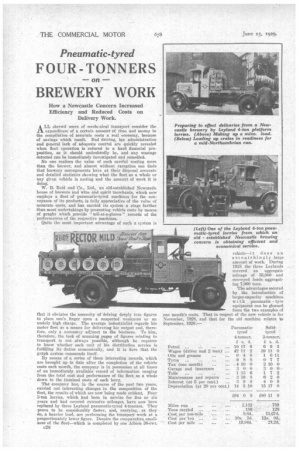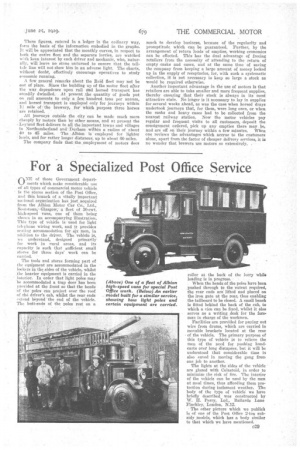Pneumatic-tyred
Page 50

Page 51

If you've noticed an error in this article please click here to report it so we can fix it.
FOUR TONNERS
-on
BREWERY WORK
How a Newcastle Concern Increased Efficiency and Reduced Costs on Delivery Work.
ALL shrewd users of teedunical transport consider the expenditure of a certain amount of time and money in the compilation of accurate costs a real economy, because of savings which result. Bad driving, lax administration and general lack of adequate control are quickly revealed when fleet operation is reduced to a hard financial proposition, as it should undoubtedly be, and any wastage detected can be immediately investigated and remedied.
No-one realizes the value of such careful costing more than the brewer, and almost without exception one finds that brewery managements have at their disposal accurate and detailed statistics showing what the fleet as a whole or any given vehicle is costing and the amount of work it is doing.
W. B. Reid and Co., Ltd., an old-established Newcastle house of brewers and wine aid spirit merchants, which now employs a fleet of pneumatic-tyred machines for the conveyance of its products, is fully appreciative of the value of accurate costs, and has carried its system a stage farther than most undertakings by presenting vehicle costs by means of graphs which provide " tell-at-a-glance " records of the performances of the respective machines.
Quite the most important advantage of such a system is
that it obviates the necessity of delving deeply into figures to place one's finger upon a suspected weakness or au unduly high charge. The average industrialist regards his motor fleet as a means for delivering his output and, therefore, only a necessary adjueet to the business. To him, therefore, the task of scanning pages of figures relating to transport is not always possible, .although he requires to know whether each unit of his distribution service is fulfilling its duties economically, and it is here that the graph system commends itself.
By means of a series of these interesting records, which are brought up to date after the completion of the vehicle costs each month, the company is in possession at all times of an immediately available record of information ranging from the total cost and performance of the fleet as a whole down to the itemized costs of each lorry.
Thg company has, in the course of the oast two years, carried out interesting changes in the composition of the fleet, the results of which are now being made evident Four 8-ton lorries, which had been in service for five or six years and had covered extensive mileages, have now been replaced by three Leyland pneumatic-tyred 4-tonners. They prove to be considerably faster, and, carrying, as they 410, a heavier load, are performing the transport ix-ork at a proportionately lower figure. Despite the comparative smallness of the fleet—which is completed by one Albion 20-cwt.
c28
vehicle—it does an astonishingly large amount of work. During 1928 the three Leylands covered an aggregate mileage of 35,000 and conveyed loads aggregating 7,000 tons.
The advantages secured by the introduction of larger-capacity machines with pneumatic tyre equipment can he gleaned from the two examples of one month's costs. That in reapeet of the new vehicle is for November, 1928, and that for the old machine relates to September, 1926:— These figures, entered in a ledger in the ordinary way, form the basis of the information embodied in the graphs. It will be appreciated that the monthly curves, in respect to both the • entire fleet and the separate lorries, are watched with keen interest by each driver and mechanic, who, naturally, will leave no stone unturned to ensure that the telltale line will not show him in an adverse light. The charts, without doubt, effectively encourage operatives to study economic running.
A few general remarks about the Reid fleet may not be out of place. Since the bpilding up of the motor fleet after the war dependence upon rail and horsed transport has steadily dwindled.' Ai present the quantity of goods put on rail amounts to only a few, hundred tons per annum, and horsed transport is employed only for journeys within .I mile of e the brewery, for which purpose three horses • are retained.
All journeys outside the city can be made much more cheaply by motors than by other means, and at present the . Leyland fleet delivers to all the important towns and villages in Northumberland and• Darham wilhin a radius of about , 40 to 45 miles. The •Albion is employed for lighter loads, and for rather longer distances, up to about GO miles. The company finds that the employment of motors does
much to develop business, because of the regularity and Promptitude which can be guaranteed. Further, by the arrangement of return loads of empties, working economies can be effected. This has the dual advantage of freeing retailers front the necessity of attending to the return of empty .casks and cases, and at the same time of saving the company from keeping a large amount of money locked up in the supply of receptacles, for, with such a systematic collection, iti is not necessary to keep so large a stock as would be required otherwise.
Another important advantage in the use of motors is that retailers are able to take smaller and more frequent supplies, thereby ensuring that their stock is always in its most attractive state. No longer is it necessary to lay in supplies for several weeks ahead, as was the case when horsed drays undertook journeys that, for them, were long ones. or when the casks and heavy cases had to be collected 'from the nearest railway station. Now the motor vehicles pay regular and frequent visits to all customers, deposit the consignment ordered, pick up any empties there may be, and are off on their journey within a few minutes. When one reviews the advantages which accrue to the customers alone, apart from. the factor of cheaper delivery services, it is no wonder that brewers use motors so extensively. .












































































































